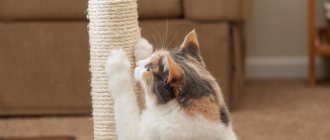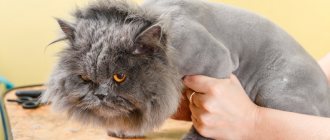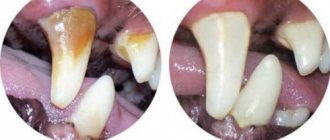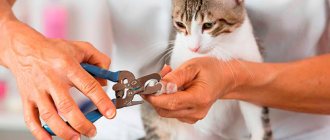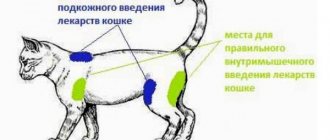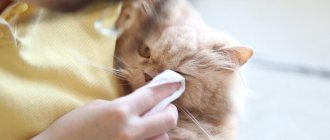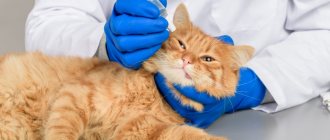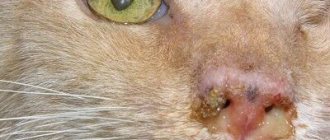Features of the structure of whiskers in cats and cats
There are no differences in the structure of the vibrissae in cats and male cats. This organ is not related to the gender of the animal and performs the same functions. The difference may be slight in length and thickness. But this is determined solely by genetics.
Locations
There is a common belief that cats have whiskers only on their faces. Long, thick hairs have been seen and known by everyone here. They are located:
- around the nose;
- on the lip pads;
- above the eyes;
- on the lower jaw, more precisely, on the chin.
But there are the same ones on the front legs. True, they are not so noticeable. But just look closely at the paw just above the place where the dewclaw is located, and you can easily spot them.
Vibrissae are located not only on the face, but also on the cat’s paws
Length
The length of the whiskers on a cat's face is on average 5–7 cm. But in this matter, much depends on the breed. So, the owners of the longest mustaches are Maine Coons. Their whiskers add incredible charm to their already charismatic appearance. In sphinxes, on the contrary, the vibrissae are very short, and often also curled. The owners of curly mustaches are cats that carry the Rex gene. The name of these breeds contains the prefix “Rex”. For example: Cornish Rex, Devon Rex and others.
The length of the whiskers is also determined by the cat’s nutrition. If it is balanced, the mustache will be truly luxurious.
Thickness
The thickness of the whiskers varies only by gender: cats have thicker whiskers than cats. You can also identify differences by location:
- the mustache on the cheeks is much thicker than above the eyes;
- on the front legs the vibrissae are only slightly ahead in thickness of the animal's guard hairs.
In general, the thickness of the vibrissae is explained by the fact that the place where each hair grows is rich in nerve endings. And if you consider that their number is quite large, then it becomes clear why the vibrissae has a tubercle at the base.
Other structural features
The vibrissae themselves are already a very mysterious organ. Each hair has a connection with its own part of the brain and is responsible only for a specific function. Therefore, if a cat loses one of its antennae, it temporarily experiences problems in hunting, coordination, touch, etc.
Each antennae is equipped with nerve endings and has its own “representation” in the brain
The main causes of breakage and loss of whiskers in cats
Whiskers and eyebrows in cats contain keratin, so if they break or are constantly falling out, you should study the possible causes of this condition:
- the development of vitamin deficiency, since the lack of essential vitamins and ascorbic acid in the animal’s body leads to insufficient production of keratin, which strengthens the pet’s mustache;
- the appearance of allergic reactions, which may be accompanied by mustache loss;
- disruption of the endocrine system (diabetes mellitus, lack of hormones also cause characteristic signs of withdrawal and loss of whiskers);
- the presence of various dermatological diseases (ringworm, parasite infection, fungus, other pathologies);
- Lack of sufficient collagen in the daily diet also affects whisker growth in animals.
A distinctive feature of Sphynx cats is the presence of short mustaches with curls, so for them this length is considered the norm and should not cause suspicion.
Most often, cats lose their whiskers when there are small children in the house who do not yet understand how serious animal twitching is. In such cases, you need to try to explain to the child that his actions are harmful to your beloved pet.
If the cat does not grow new whiskers, then he could damage the hair capsules, which contributed to normal growth and restoration of the whiskers. Therefore, consultation with a qualified veterinarian is required.
Why do cats need whiskers?
All animals from the cat family have good hearing, a sense of smell and a specific organ called whiskers (vibrissae) in the form of coarse hairs near the mouth, which have a pronounced function of touch. The bases of the organ are located on the surface of the skin and are connected to a large number of nerve endings.
Vibrissae transmit special impulses to the brain to receive certain information. Therefore, if you cut off a cat’s whiskers, it may lose important functions for the body:
- orientation in the environment. It is with the help of their whiskers that cats are well oriented in the place where they are, since the whiskers transmit impulses about the presence of possible obstacles. The animal’s brain begins to solve the problem after receiving the appropriate signal;
- moving a cat at night. This function is especially useful for elderly animals whose visual acuity is impaired;
- successful jumping by cats, since with the help of their whiskers the animals accurately calculate the distance, trajectory and angle, the force of the body flight for successful hunting and protection when meeting an enemy;
- normalization of the vestibular apparatus, which ensures the animal’s balance while walking, jumping, running;
- the mustache is an integral assistant during hunting, since the sense of touch helps to establish the direction of the wind, the smell of the prey and its path of movement in complete darkness;
- With the help of their whiskers, cats can determine the depth of various holes. Reflective impulses from the walls transmit a signal to the brain, and the animal can assess the danger of a particular situation for itself;
- cats without whiskers cannot normally determine the temperature of food, liquids and recognize their nutritional characteristics;
You may be interested in: Why do cats purr and how do they do it?
- many experts confirm that with the help of their whiskers, cats can detect magnetic changes in the earth and predict meteorological weather conditions;
- one or another position of the whiskers may indicate the mood of the pet (spaced and raised whiskers indicate a strong interest in the cat, and if they are pressed to the muzzle, then the animal experiences a feeling of fear).
Therefore, if a cat’s whiskers are cut, the animal will lose all of the above functions, which will negatively affect its general condition.
What are vibrissae and what will happen if you cut them
Vibrissae, or whiskers, of an animal are long, sensitive, tactile hairs that are tougher than the main coat. A cat's set of vibrissae consists of 24 movable hairs (on average), 12 on each side. The roots of the mustache are deep and connected to the nervous system much more densely than ordinary hair follicles.
If you trim a cat's whiskers, he will lose part of his perfect navigation system. At night, the cat will not be able to navigate the space so well, which is not at all good for its safety. A cat's night vision is not as perfect as is commonly believed; it can feel the sharp thorns of plants! Without whiskers, your furry pet can damage its eyes, nose, and ears.
Veterinarians advise keeping cats indoors until their whiskers grow back. It is not recommended to even rearrange the room, since a cat without whiskers will not be able to walk around the house freely and without the risk of hitting itself.
Of course, nothing particularly bad may happen from trimming a cat’s whiskers. But why risk the animal's health? Try to convey this information to children so that they do not play around with scissors while playing hairdresser with pets.
General rules
You can work with the hair of some animal breeds with scissors.
To be safe, new haircuts for cats are done according to certain standards and recommendations. you should know who and how you can groom. It is allowed to cut a Persian cat and a pet with another long-haired breed using scissors, a mechanical hand or an electric machine. A Scotsman or a Briton can only be groomed with a machine, and scissors cannot be used to work with the hair of a Siamese cat. At the end of the process, the animal is bathed in warm water to remove small clipped hairs.
After the haircut, the cat should receive positive emotions in the form of a soothing, gentle stroking and tasty treats - this way the fright will go away faster. If the pet is shaved bald, the discomfort and anxiety will subside when the cat grows new fur 3-5 mm long, so that the animal does not attack its own tail, not perceiving it as its own, a brush is always left at the end.
Safety of the procedure
The absence of injuries is one of the main criteria for professional work. The fur is usually removed against the grain, but shaving the pet’s coat in the opposite direction is also acceptable, especially if these are small kittens or nervous adult purrs. Cutting hair according to hair growth makes it possible not to cause additional discomfort and stress to the animal.
Before treatment with a machine, the tummy is carefully trimmed with scissors, paying special attention to the area of the nipples so as not to damage them.
A special collar is necessary for animals that are prone to nervousness and aggression during grooming.
If the animal is nervous, put on a collar and groom without anesthesia. A pet wearing a collar does not see what is happening and is less nervous; besides, this way it will not be able to bite the hairdresser. Particularly aggressive patients are groomed with immobilization - the master's assistant firmly holds the cat by the paws and head, not allowing him to twitch and interfere with the process. If there are a large number of mats and it is necessary to completely cut off the fur, the “aggressor” must be groomed under anesthesia.
An effective method to immobilize a cat
The process of immobilizing young healthy cats includes the following steps:
- Attaching the clip to the cat's scruff. You need to select a clothespin or clip approximately 5 cm in size and place the device on the withers directly behind the ears. Each owner can choose what exactly to pinch the scruff of the neck on their own. You need to look at the cat’s reaction to see what suits him best. If a paper clip puts too much pressure on the skin, the cat will not tolerate the pain.
- It is necessary to place the pet on its side. Since the cat relaxes too much after the clamp, he may involuntarily fall on his own. If this does not happen, you can gently press on the hind legs to remove resistance. You can tell that the cat is completely relaxed by his behavior. He tends to pull the lamps towards his muzzle, curls up into a ball, and places his tail between his paws. If the cat cannot be laid on its side, it continues to stubbornly stand on its feet and tucks its tail, which means it is not calm and is very scared.
- Using additional clothespins. The reception will help to completely relax the animal. To do this, several clamps must be placed a little further than the first one on the back of the neck along the spine. If the cat starts to get violent, then all the clamps need to be removed.
- Also, the method of placing a clothespin anywhere along the back along the spine may work for some cats, but greater effect can only be achieved when placed on the neck.
- After a few minutes, the clothespins need to be removed. However, the duration of the resulting peace of mind is sometimes completely unpredictable and is determined on an individual basis. Some cats are immobilized during the entire grooming and nail trimming procedure, while in other cases the animal can be deactivated for a short period of time.
According to veterinarians, clothespins cannot cause harm to the skin. But after some time, the cat may begin to show dissatisfaction; there is no need to shock the cat for a long time.
When keeping pets, there is often a need to perform certain procedures that require their immobility. If this is a cat, then he needs to trim his claws, get a haircut, perform medical procedures, for example, give injections
With all these procedures, it is important to know how to immobilize a cat correctly. After all, they are all stressful for the animal, which means it can behave completely unpredictably, injuring both itself and those around it.
To keep the cat from moving, it is not necessary to use sedatives or other tranquilizers; you can get by with another working method.
How to properly cut a cat's hair
When cutting hair, it is advisable to find an assistant. He will hold the animal lying on its side, control the front legs with one hand and the hind legs with the other. It is necessary to fix the pet on the table surface quite firmly - the cat will escape out of fear, and the sound of the running machine will provoke it to escape. Try to use silent machines. It is necessary to cut cats according to a certain algorithm: start cutting from the sides, back and belly, move to the armpits, then the back. Then come the paws; if you wish, you can leave the “socks”. It is not necessary to cut the tail, but if you decide to tidy it up, leave a tassel at the end. If you decide to cut your cat's hair against the grain, use scissors and a special clipper, setting the cutting depth to 3 to 4 mm, which will prevent injury to the animal's skin. Do not forget to stretch the animal's skin in the area where the machine passes. Cutting against the grain is different in that a larger volume of hair is removed in one pass, but this method is mentally traumatic for the animal. After finishing the haircut, wipe the cat with wet wipes, or better yet, give it a bath to remove any remaining fur. Now all the fears are over, and she is ready to return to her normal life. This process is not simple, it has many nuances, and not all animals tolerate haircuts calmly. If you do not have enough skills to groom your pet on your own, it is better to contact a groomer: go to a special salon or call them to your home.
What happens if you cut off an animal's mustache and eyebrows?
The role of whiskers in the life of cats is great, so if they are trimmed, they will at least experience discomfort. According to research, animals without whiskers have poorer spatial orientation because their brains lack information about the world around them. Cats begin to bump into objects and get stuck in narrow holes. During jumps, they often fall, not reaching the desired object or missing. Street animals especially suffer from the loss of whiskers - they cannot fully hunt, experience problems with food, and are often injured.
Different cats react differently to damage to the whiskers: the behavior of some is not particularly different from usual, others feel extremely insecure without them, become more withdrawn and nervous, move less, and their mental state worsens. A cat without a whisker loses coordination, so you should be careful and not let a whiskered animal out of the house to avoid injury.
You can trim a cat's whiskers only in one case - if nearby tissues are injured or infected. This is necessary to carry out treatment and prevent the development of complications. In this case, the mustache is cut off by a veterinarian. In other cases, trimming a cat's whiskers is unacceptable.
Consequences of loss
The consequences of trimming cats' whiskers can be very varied and depend on whether the animal is a pet or an outdoor one, as well as on individual characteristics. The most difficult situation for the lack of their sensory sensors is street cats who are forced to get their food in the wild. Without whiskers, it will be difficult for backyard predators to track their prey and hunt successfully.
What happens if a cat's whiskers are trimmed depends on the individual sensitivity of a particular pet.
At first, some animals may lose the ability to navigate normally in the surrounding space.
There are cases where cats deprived of whiskers could not walk in a straight line for a certain time, fell and lost orientation in space. This failure in the animal’s navigation system is due to a sharp lack of signals about the environment entering the brain.
Of course, such extreme manifestations are not typical for all animals. Most often, the loss of whiskers leads to the fact that it is more difficult for a pet to make accurate jumps and navigate in the dark. Without whiskers, a cat more often stumbles upon obstacles and does not navigate in an unfamiliar environment.
Veterinary experts under no circumstances advise owners to trim or trim their animal's whiskers. Such manipulation can lead to stress, fearfulness, and inappropriate behavior. Some especially sensitive pets have a hard time coping with the loss of their whiskers: they become withdrawn and become non-communicative. Cats sleep for a long time and stop leading an active lifestyle.
To see what happens if you cut a cat's whiskers, watch this video:
Why you can't trim cats' whiskers
Without the vibrissae on the muzzle, the life of members of the family would be much more difficult. Cat whiskers perform a number of vital functions:
- First, whiskers help cats find food. Cats find food not only visually, but also by smell. Vibrissae help cats react correctly to the movements of prey. So, for example, having caught a mouse, a cat runs its whiskers along it, determining whether the victim is alive or not. A cat will not eat a live mouse - this is fraught with damage to the gastrointestinal tract and infection. If the cat does not try to touch the prey with its whiskers, but does it with its paw, then the pet’s whiskers are somehow damaged;
- Secondly, whiskers help cats navigate correctly in space. If a cat gets lost in an unfamiliar area, he will use his whiskers as a kind of compass that will help him find his way home. The animal will tilt its muzzle towards the ground so that its whiskers also touch the road and thus look for the way to its home;
- Thirdly, the owner of the animal can determine the mood of the pet by looking at its whiskers and find out about its well-being. If the whiskers puff up “vigorously”, this indicates that the cat feels good and is in a good mood for games and active fun. If the whiskers stick out in different directions, the pet is extremely aggressive, it is better to leave it alone for a while. Drooping whiskers will tell the cat's owner that the pet is worried about something and may not be feeling too well;
- Fourthly, whiskers help cats correctly assess distance when jumping. Using its whiskers, the animal determines whether it can make an accurate jump or not;
- Fifthly, whiskers help cats determine the depth of space. Using its antennae, the cat determines whether it will be able to crawl into a certain hole;
- Sixthly, vibrissae help determine the temperature of an object, food. By using the whiskers, the cat will understand if there is a risk of getting burned by touching this or that object.
By the way, if there is a fight between cats in the wild and one of the rivals tears off or gnaws off the whiskers of the other, then the side that has lost its whiskers will give up its position and retreat.
As you can see, cats’ whiskers are truly an extremely important and vital organ for the animal. Therefore, under no circumstances should cats’ whiskers be trimmed.
What should a pet owner do if a cat for some reason has lost its whiskers?
Knowing that cats’ whiskers cannot be cut and understanding how important they are for the animal, its owner can be quite concerned. This applies to the situation if the pet loses its whiskers after a fight with another cat or injury. What to do under such circumstances?
Let us immediately note that specialized treatment for such cases has not yet been developed, as well as means that accelerate the growth of whiskers. You will need to wait until your cat's whiskers grow back naturally. This usually happens within 2-3 weeks. As you can see, the vibrissae grow quite quickly, however, provided that the hair follicle has not been damaged.
Some cat owners wonder if trimming their whiskers will help speed up their growth? The answer to this question will be negative. The animal's antennae must grow on their own, and the only thing that can be done to help the pet is to enrich its diet with vitamins, to make the menu more nutritious and healthy.
The main components of a cat's whiskers
If you constantly observe the habits of these wonderful and affectionate animals, then why they need whiskers is not so difficult to guess. The most important components of a cat's happiness are: communication, hunting instinct and, of course, orientation.
Hunting instinct
When tracking its prey, each cat, first of all, uses its excellent hearing and vision. Tactile sensations are also at their maximum level at this time. Cats, touching the floor with their whiskers, feel all the vibrations that are created by the paws of mice. A mouse that tries to escape breaks the air currents with its movements, so the cat's whiskers begin to move. That is why a cat can easily determine which direction the prey has chosen for itself and purposefully heads in its direction. If a cat manages to catch a mouse, then, holding it in its teeth, it feels it with its antennae. In this way, she can distinguish whether her prey is alive or no longer alive. If the mouse is still alive, the cat will not eat it. She can play with her for a long time and torture her so that she finally stops breathing. And only then does he start eating. But why does a cat need a mustache if it is fed by its loving owners?
With its whiskers, a cat determines the safety of its food, regardless of whether it is a mouse or simple cat food. Cat breeders have probably already observed more than once that when a cat is presented with a plate of food, it stretches out its antennae towards it, sniffs the food and only then starts eating. This way she evaluates the safety level of her food.
If for some reason a cat has lost its whiskers, then it becomes very careful, touching food with its paw, walking around it or trying to move it from place to place. This situation frightens the cat and it becomes more cautious and insecure.
Orientation
Many pet owners have probably noticed that their cat's whiskers break for some reason. The most common reason for this is the strongest use of this organ in order to somehow navigate in space. When a cat moves around a room in complete darkness, it lowers its muzzle to the floor and thus feels all the vibrations passing nearby. Moreover, whiskers in the dark help the cat overcome obstacles and also calculate the route. Whiskers breakage occurs when the cat often moves in the dark and is nocturnal.
Communication
Based on the principle of how a cat's whiskers are positioned, you can understand what kind of attitude it has towards its owners, towards strangers, and even towards its rival cat. If you notice that the whiskers are scattered in different directions, then the cat is quite aggressive and it is not recommended to approach it. Sometimes cats bristle their whiskers during active play. If a cat presses its whiskers tightly to its muzzle, this may indicate that it does not want to let anyone near it. It is even possible that she does not feel very well or that she does not like this or that room, person or animal sitting next to her.
The cause of mustache loss is completely unclear in many ways. It happens that there are several animals in the house and one of them is constantly trying to pick out the whiskers of its “friend”. Scientific research has shown that this is one of the ways in which one cat wants to dominate another. Without antennae, a cat loses self-confidence, so it is much easier for the second one to subjugate it.
Why does a cat need a mustache?
A kitten without a whisker loses orientation in space
Vibrissae are the sixth sense organ directly connected to the brain. With their help, life is regulated: from touch to communication with furry fellows. If you don’t know why cats absolutely cannot have their whiskers cut, you can seriously harm them. Whiskers are not ordinary fur, and their loss deprives the pet of the opportunity to safely walk down the street, explore unfamiliar types of food, or hunt.
A kitten without whiskers loses orientation in space Vibrissae are multifunctional devices designed by nature as an additional sensory organ. They help cats hunt. A running mouse creates air vibrations that are instantly picked up by a small predator. The pet determines:
- the exact location of your victim;
- her condition;
- the point to which the enemy moves.
After capturing the mouse, the hairs growing on the cat's front paws come to the rescue. With their help, she controls the behavior of the victim, assesses the situation, determines the location and strength of resistance of the rodent or bird.
When communicating with fellow creatures, the mustache plays a big role. An animal’s reaction to the appearance of an unfamiliar individual or person can be determined by the position of its whiskers:
- If they are aimed at the subject of study, then the pet is interested in communication, it emanates friendliness.
- If they are pressed together with the ears, then attempts to pet the cat will lead to scratches, bites and the rapid disappearance of an aggressive animal.
Important! Vibrissae are the first to form during the embryonic development of babies. They help the newborn quickly establish contact with the outside world, identify the mother and brothers
It’s better not to even think about what will happen if a newborn cat’s whiskers are trimmed. You should not do this, because until they are restored the baby will be deaf and blind and will be afraid to move.
Difference from hairs
The physiological characteristics of vibrissae include their deep insertion into the skin. Each of the antennae is a kind of antenna, surrounded by many nerve endings. They are used to transmit received signals to the brain center.
Vibrissae are complex receptors equipped with muscle fibers. They are responsible for the sense of touch, and their appearance is associated with evolutionary changes in the furry pet’s body. The longest ones are located on top, the shortest ones are located in the chin area. The main help of sensitive antennas is the ability to quickly and silently hunt birds and rodents at night.
Whiskers help cats hunt
Important! By the whiskers you can evaluate the cat's next action. Splayed - intended to intimidate the enemy, directed in the opposite direction - indicate anxiety and uncertainty of the pet
Sensitivity
Resourcefulness and cunning are important character traits not only of an adult, but also of a small kitten. If you cut a cat's whiskers, what will happen to it:
- sensitivity to possible danger will decrease;
- the definition of the road will be lost in complete darkness;
- the reaction to environmental changes will disappear.
Touch is one of the important functions of vibrissae. With its help, pets will find out the safety of the food offered and its freshness. In pitch darkness, the animal easily avoids objects standing in the way by touching them with its whiskers. In some cases, direct contact is not necessary: due to the mobility and vibration of hard hairs, air vibrations are created, the reflection of which from foreign objects is caught by the vibrissae. After transmitting the signal to the brain center, the cat receives a three-dimensional image of space.
If a cat's whiskers are cut off, what will happen to it during a chase:
- she will not be able to determine the diameter of the hole she is going to crawl into;
- may get stuck in it;
- she will not be able to hide from her pursuer.
Important! Veterinarians have noticed that the loss of sensitive hairs for various reasons leads to the development of neuropsychiatric disorders in furry pets. They lose the skills to receive and process information, become defenseless, and behave inappropriately
What happens if you cut off a cat's whiskers?
The consequences of this can be very serious, so you shouldn’t cut your pet’s whiskers just for fun or on a whim. They are shortened only in cases where it is necessary for health - for example, if there is an open wound or abscess on the muzzle. Then you have to shave the hair along with the mustache, because... To avoid infection, you need to treat the entire affected area of skin. But even in this situation, the loss of vibrissae is extremely painful for animals.
In fact, as a result of this, the cat’s emotional background changes, and it may be in a bad mood. What is not surprising is that there is a deterioration in orientation in space, the ability to quickly respond to environmental factors, and many other properties that the pet had thanks to its mustache.
Of course, cats grow whiskers. Moreover, this happens at a pace three times faster than the rate of fur regrowth. This fact only confirms how important the mustache plays.
Do whiskers break and why does a cat need whiskers?
The most harmless case is genetic predisposition. A cat's whiskers break on their own, for example, in sphinxes.
Does your cat's whiskers sometimes become soft and brittle? This is a sure sign of a lack of vitamins - vitamin deficiency. It is worth reviewing your pet’s diet or changing food. It is also possible to add some special vitamins, which your veterinary clinic can help you choose. The most unpleasant thing that can happen to a cat is that it gets worms.
If a kitten’s whiskers break, you should worry a little more, because the baby is still a growing organism. All that can be done in this situation is to add more vitamins to the kitten’s menu: a spoonful of vegetable oil in the porridge, a little cottage cheese at night or a little milk in the morning. Or change the dry ration in favor of something more enriched with minerals and everything necessary.
Why do cats' whiskers turn black or white?
The color of the whiskers directly depends on the color of the animal itself. They can be white, black, red or several colors at the same time. Usually a black cat has black whiskers, but sometimes white whiskers are normal. In some breeds they turn black over time.
If a cat with a white mustache has acquired a black color, this phenomenon also does not mean anything terrible, just a normal change in hair pigmentation. You should be wary if the color, on the contrary, changes to white. Sometimes this can be a symptom of a disease. Therefore, even with a slight deviation, it is worth consulting with a veterinarian.
It's hard to imagine a cat without a luxurious mustache! However, nature did not invent them for beauty. Century after century, whiskers have helped cats survive in the wild, and today house hunters cannot do without them either. So what is their function? About this in our article.
What is the correct name for a cat's whiskers and what are they?
Cats' whiskers grow not only under the nose, but also on the forehead, near the eyes, on the chin and even on the paws. More precisely, it is correct to call them not “whiskers”, but “vibrissae”. These are sensitive, hard hairs, longer than the coat. In total, there are about 40 such hairs on a cat’s body, and only 24 of them are on the face.
Unlike simple hair, vibrissae are surrounded by hundreds of nerve endings and muscle fibers, and their root goes deep into the tissue.
Each whisker is a separate organ of touch, which continuously transmits a signal to the animal’s brain 24 hours a day. Vibrissae are present not only in cats, but also in many other mammals, including dogs.
Why does a cat need a mustache?
Vibrissae pick up the slightest vibrations in the air and help cats navigate in space. With such “devices”, even at night in an unfamiliar room, the cat will not crash into objects, will always smell the mouse and accurately calculate the jump distance.
Vibrissae help the cat understand whether food is safe. In the wild, the hunter seems to wrap her whiskers around a caught mouse, determining whether the prey is dead and whether it is possible to start eating. In a similar way, your pet analyzes food and treats at home
Caution in such matters is never superfluous!
Vibrissae serve for cats to communicate with each other and with humans. An attentive owner will always determine the mood of the pet by the position of the whiskers.
Is it possible to trim a cat's whiskers?
Is it possible to shorten cats' whiskers? Any specialist will answer: under no circumstances. The vibrissae are an important organ, the loss of which will result in extreme stress for the cat. A cat that suddenly loses its whiskers will become less aware of space and will feel defenseless and vulnerable until new ones grow.
Adults must explain to children that pulling out a cat's whiskers is prohibited. In addition to loss of function, it is also very painful, since the whiskers, unlike wool, are rooted deep into the tissue. Cat whiskers must remain untouchable!
What to do if your cat's whiskers fall out?
Now we know how important whiskers are for a cat. But what if they suddenly started falling out? Should we sound the alarm?
From time to time, the vibrissae are renewed in the same way as animal fur and human hair. Therefore, if you notice a fallen or broken mustache at home, there is no need to worry. This is fine!
It’s another matter if the vibrissae fall out and break in large numbers. This is a signal that something is wrong with the body. Perhaps it is a matter of seasonal adjustment, or perhaps an internal illness. Don't ignore the problem and contact your veterinarian.

